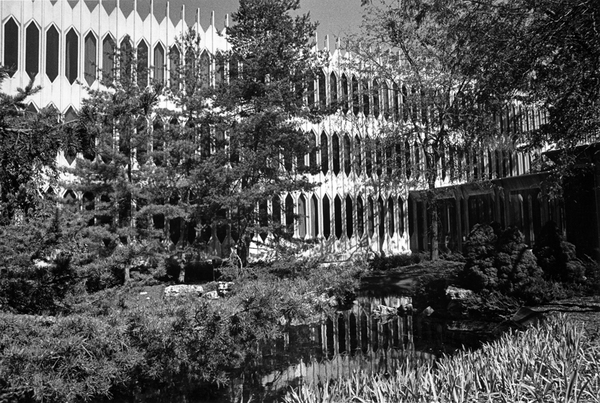Conservatory of Music
Date
Warner Concert Hall: 1963-presentMain Conservatory building: 1964-present
Library addition: 1988-present
Kohl Building: 2010-present
Location
77 West College StreetArchitects/Collaborators
Minoru Yamasaki and Associates, Troy, MI (architect)John G. Ruhlin Construction Co., Akron, OH (contractor)
Bolt, Beranek and Newman, Inc., Downers Grove, IL (acoustical consultant)
Eichstedt and Grissim, Associates, Grosse Pointe, MI (landscape architect)
Conservatory Library addition:
Gunnar Birkerts & Associates, Birmingham, MI (architect)
Donald Fry, Norwalk, OH (contractor)
Kohl (Bertram & Judith) Building:
Westlake Reed Leskosky, Cleveland, Phoenix, Washington, New York, Los Angeles (architects)
Style
New Formalism, Postmodern
History
Oberlin's Warner Hall, the Conservatory's building from 1884, was no longer adequate at the beginning of the 1960s. The college chose Minoru Yamasaki to design a new complex, including a library, for the music school. The resulting building in steel-reinforced quartz-aggregate exemplifies Yamasaki's "space-age gothic" version of New Formalism. The main segment of the building (Bibbins Hall) is a rectangle with its long side facing College Street. The entry is to the west of the center, and is dominated by five windows that extend to the top of the three-story atrium. The middle three windows have doors as their lowest segment. The rest of the façade is an uninterrupted row of narrow, floor-to-ceiling hexagonal windows on each floor. Behind Bibbins, a one-story hallway extends back to the one-story lounge and the two-story Kulas Recital Hall. Beyond those is the three-story Warner Concert Hall, with recessed hexagonal windows perforating its otherwise-blank wall.The courtyard formed by Bibbins, the lounge, and Warner Concert Hall (completed in 1963) holds an ornamental Japanese garden and pond (with plant specimens personally selected by the architect) and an entry plaza leading to the double doors of the lounge. The windows of the lounge are a variation on the hexagon motif. Yamasaki also designed the King Memorial Building, diagonally across the street, in a very similar design.
See also the Conservatory Library Addition, 1988, and the Kohl Building, 2010.
Sources
Ohio Historic Inventory for Oberlin College Conservatory of Music by H. Petersen, M. Franck, D. Musson, and O.H.I.O. Interns, Ohio Historic Preservation Office, 2002, accessed from the Oberlin Heritage Center website, May 22, 2015.
Oberlin College Archives, College General Records, Buildings and Dedications.
Geolocation
Image Description
Conservatory of Music courtyard and Japanese garden with reflecting pool.
Black and white, gelatin silver 8 x 10 in. vintage print, ca. 1965
(© Oberlin College Archives, RG 32/4)

